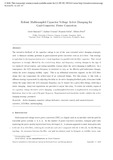Mostrar el registro sencillo del ítem
Robust multisampled capacitor voltage active damping for grid-connected power converters
| dc.creator | Samanes Pascual, Javier | es_ES |
| dc.creator | Urtasun Erburu, Andoni | es_ES |
| dc.creator | Gubía Villabona, Eugenio | es_ES |
| dc.creator | Petri, Alberto | es_ES |
| dc.date.accessioned | 2018-11-08T18:01:06Z | |
| dc.date.available | 2021-02-01T00:00:10Z | |
| dc.date.issued | 2019 | |
| dc.identifier.issn | 0142-0615 | |
| dc.identifier.uri | https://hdl.handle.net/2454/31361 | |
| dc.description.abstract | The derivative feedback of the capacitor voltage is one of the most extended active damping strategies, used to eliminate stability problems in grid-connected power converters with an LCL filter. This strategy is equivalent to the implementation of a virtual impedance in parallel with the filter capacitor. This virtual impedance is strongly affected by the control loop delays and frequency, creating changes in the sign of the emulated virtual resistor, and raising instability regions where the active damping is ineffective. As a consequence, the LCL resonance frequency is restricted to vary, as the effective grid inductance changes, within the active damping stability region. This is an additional restriction imposed on the LCL filter design that can compromise the achievement of an optimised design. For this reason, in this work, a different strategy is presented; by adjusting the delay in the active damping feedback path, it becomes stable within the range where the LCL resonance frequency can be located for a given filter design, achieving a robust damping. Analytical expressions are provided to adjust this delay. To widen the stability region of the capacitor voltage derivative active damping, a multisampled derivative is implemented, overcoming its limitations close to the control Nyquist frequency. Experimental and simulation results validate the active damping strategy presented. | en |
| dc.description.sponsorship | This work has been supported by the Spanish State Research Agency (AEI) and FEDER-UE under grant DPI2016-80641-R. This work was partially funded by the Public University of Navarre through a doctoral scholarship. | en |
| dc.format.mimetype | application/pdf | en |
| dc.language.iso | eng | en |
| dc.publisher | Elsevier | en |
| dc.relation.ispartof | International Journal of Electrical Power & Energy Systems, vol. 105, pp. 741-752 | en |
| dc.rights | © 2017 Elsevier Ltd. The manuscript version is made available under the CC BY-NC-ND 4.0 license. | en |
| dc.rights.uri | https://creativecommons.org/licenses/by-nc-nd/4.0/ | |
| dc.subject | Active damping | en |
| dc.subject | Capacitor voltage derivative | en |
| dc.subject | Converter control | en |
| dc.subject | Grid connected power converter | en |
| dc.subject | LCL-filter | en |
| dc.subject | Multisampling | en |
| dc.title | Robust multisampled capacitor voltage active damping for grid-connected power converters | en |
| dc.type | Artículo / Artikulua | es |
| dc.type | info:eu-repo/semantics/article | en |
| dc.contributor.department | Ingeniería Eléctrica, Electrónica y de Comunicación | es_ES |
| dc.contributor.department | Ingeniaritza Elektrikoa, Elektronikoa eta Telekomunikazio Ingeniaritza | eu |
| dc.rights.accessRights | Acceso abierto / Sarbide irekia | es |
| dc.rights.accessRights | info:eu-repo/semantics/openAccess | en |
| dc.embargo.terms | 2021-02-01 | |
| dc.identifier.doi | 10.1016/j.ijepes.2018.09.014 | |
| dc.relation.projectID | info:eu-repo/grantAgreement/ES/1PE/DPI2016-80641-R | en |
| dc.relation.publisherversion | https://doi.org/10.1016/j.ijepes.2018.09.014 | |
| dc.type.version | Versión aceptada / Onetsi den bertsioa | es |
| dc.type.version | info:eu-repo/semantics/acceptedVersion | en |
| dc.contributor.funder | Universidad Pública de Navarra / Nafarroako Unibertsitate Publikoa | es |



